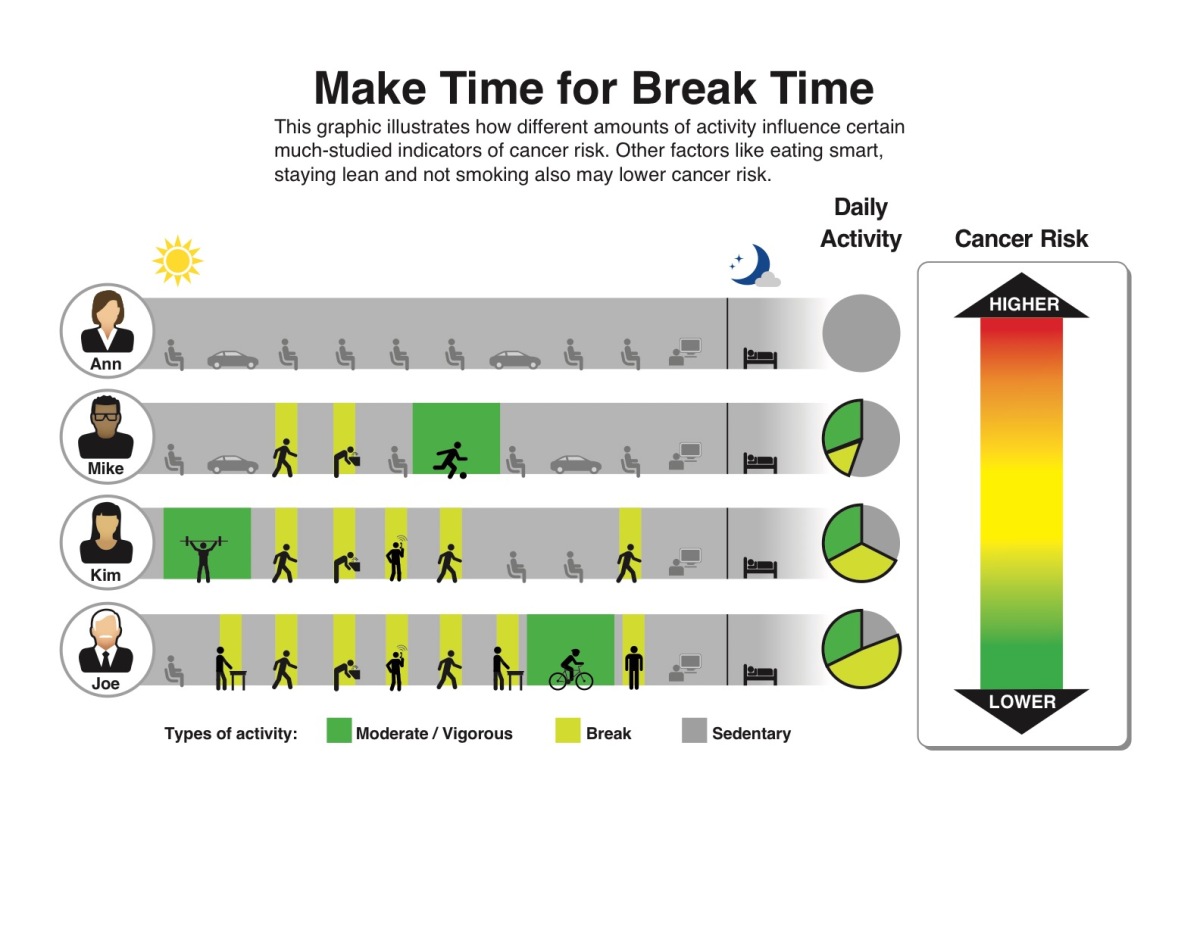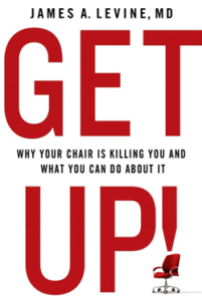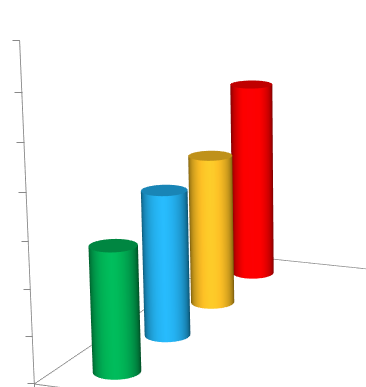The benefits of exercise have been well documented. So don’t stop. However, research about we how spend the rest of our time not exercising paints a different picture. So, what I am I talking about?
Each day we are given 24 hours. What we do with our time, related to overall physical activity, is very important. Of those 24-hours, it is recommended that adults sleep for an average of 8 hours per night. That leaves us with 16 waking hours. Now, add in an hour of moderate vigorous physical activity each day, and you are down to 15 hours. A lot goes into those remaining 15 hours: Typical work shift 8-9 hours, 1-2 hours of commute, and an additional 3-4 hours of leisure time.
Unfortunately, during the 15-16 hours of our waking hours, work and leisure activities are spent sedentary, or sitting down. Take a look at the graphic below:
 (Image credit: American Institute for Cancer Research)
(Image credit: American Institute for Cancer Research)
You can see a variety of physical activity levels between Ann, Mike, Kim, and Joe.
- It appears Ann did not exercise and sat all day
- Joe exercised and was up and about more often
- Mike and Kim exercised, but did not engage in as many sedentary activity breaks
- Overall, Joe was the most active.
The convenient “Cancer Risk” thermometer to the right shows us that Ann is most at-risk and Joe is least at-risk for various types of cancer. We should all be more like Joe.
Why is this such a big deal? Contrary to what you may believe, or never thought of before, exercising doesn’t protect every risk factor, even if you meet physical activity recommendations. In research terms, the amount of exercise is independent of the risks described earlier. A study in 2012 confirmed this.
The Evidence Against Sitting
Amount of Sitting/Day – this axis describes the number of hours people reported sitting each day
- 0 to <4h/d = People sat for 0 – 4 hours each day
- 4 to <8h/d = People sat for 4 – 8 hours each day
- 8 to <11h/d = People sat for 8 – 11 hours each day
- Greater than 11h/d = People sat for more than 11 hours each day
Minutes of Physical Activity Per week – this axis describes the amount of exercise people reported engaging in each week
- Red Columns = People that exercised 0 minutes per week
- Yellow Columns = People that exercised 1 – 149 minutes per week
- Blue Columns = People that exercise 150 – 299 minutes per week
- Green Columns = People that exercised 300+ minutes per week
So, if you take any group of people (based on exercise time/column color) and move left to right, the risk of death (taller columns) increases the more people sat. This pattern emerges no matter which group of people you start with. The risk of death increases for each of the red, yellow, blue and green groups. You can begin comparing different combinations in the chart above. Even if somebody exercises all the time, but sits all day (tallest green column), he or she may be putting themselves more at risk for death than somebody that exercises 1 – 149 minutes per week and sits 4-8 hours (second tallest yellow column).
From the chart above we find:
- The healthiest group
- Exercises 300 minutes per week, and
- Sits around 4 hours each day
- The unhealthiest group
- Exercises 0 minutes per week, and
- Sits more than 11 hours each day
This is intuitive. Just to review, the chart above shows that even if you exercise, sitting all day still increases your risk for disease and death. If exercise was protective, all the bars would be the same height moving left to right. Now you can have fun (or not) and figure which column you are in.
Instructions:
- Select the column that describes how much you sit each day, and
- Intersect with that column with the amount exercise you get each week
Voila! You now know which risk category you are in.
Exercise is Good
You can also see the benefits of exercise in the same chart above. If you just take one column of sitting time, in this case sitting 0 – 4 hours per day:
Not exercising (the red column) puts you at risk far greater than the other exercise amounts. In this example, more exercise time per week results in reduced risk of death. For the most part, you can see in each of this trend for all other amounts of sitting time (4-8 hours, 8-11 hours, and >11 hours).
This study, as well as other recent publications, are pointing all of us in the direction as being more active, all the time. Meeting the MVPA guidelines is not enough. Dr. James Levine recently published Get Up! Why your chair is killing you and what do to about it. It is an easy read and I highly recommend it.

Dr. Levine coins a term called Nonexercise Activity Thermogenesis (NEAT). NEAT is the energy expended for everything we do that is not sleeping, eating or sports-like exercise (Levine, 2004). All of the automatic car doors, sensors, dishwashers, lawn mowers, hi-tech gadgets, and especially, sedentary office spaces, in our world all decreases our NEAT that is expended each day. So, we need to engage in more general activity (if you are a senior, Dr. Joan Vernikos recommends firing your housekeeper; see point #15).
This type of research was the springboard for the boom in the popularity and sales of standing desks (you expend more energy standing than sitting, contributing to more NEAT).
We can now revisit the graphic above with Ann, Mike, Kim and Joe. Joe is at the least risk for cancer because he exercises and moves more throughout his day. I may be sending an even more difficult message to some readers. To be in the healthiest group, I have exercise and move more. It may be difficult to start and maintain a successful exercise program, but maybe getting up and moving more throughout the day may be feasible right now (could be a rationale for getting that treadmill desk you always wanted).
What is the Behavioral Focus?
So, if exercising does not wipe out all the risks of diseases, cancers, or other health problems, then what are we to do? How can we begin targeting such a large issue from a behavioral perspective?
….we start with what we know best: Antecedents, Behaviors, and Consequences.
The Target Behavior(s)/Area of Concern:
Increasing general overall physical activity (or NEAT) each day
Antecedents to consider:
- Seating arrangement – How is your desk or home office arranged? Are you more likely to sit or stand when working?

- Work transitions – How close are the stairs? Elevator? Do you park in the closest or farthest spot in the company lot?
 Type of work – What are your work tasks on a given day? Do some tasks require sedentary activity (typing/writing)? Can you work on your feet?
Type of work – What are your work tasks on a given day? Do some tasks require sedentary activity (typing/writing)? Can you work on your feet?
Consequences to consider:
- Social consequences – Are colleagues supportive of a more active work place? Can you arrange a walking break with a coworker?
 Physical consequences – Is it physically difficult to take the stairs? Are there certain aches and pains related to prolonged sitting or standing?
Physical consequences – Is it physically difficult to take the stairs? Are there certain aches and pains related to prolonged sitting or standing?
- Work completion – Do certain tasks require you remain inactive for extended periods of time? Can you ask you boss for leniency on a dead line (to accommodate more 5-10 minute walking breaks)

Based on the evidence above, our time should not only spent on specific exercise regimens, but on increasing general activity levels throughout our day. Levine’s NEAT acronym works great to separate the two forms of physical activity that is beneficial to us. The environment is filled with opportunities that make it more or less likely to engage in physical activity. Understanding the antecedents and consequences in your personal environment will be essential to creating a physically active day.
Again, exercise is great…but it is not everything.
References:
Levine, J. A. (2004). Nonexercise activity thermogenesis (NEAT): environment and biology. American Journal of Physiology-Endocrinology And Metabolism, 286(5), E675-E685.
Van der Ploeg, H. P., Chey, T., Korda, R. J., Banks, E., & Bauman, A. (2012). Sitting time and all-cause mortality risk in 222 497 Australian adults. Archives of internal medicine, 172(6), 494-500.





Awesome info Nick! We miss you guys, I hope you have a nice visit this weekend, so sad we will miss you!
Fran
I am glad you enjoyed the article!
Pingback: 2015 in Review: BehaviorFit’s First 5 Articles | BehaviorFit
Pingback: How to Hack Physical Activity for Your Next Conference – BehaviorFit
Pingback: 8 Ways to be Active at Work | BehaviorFit
Pingback: CORRECTION! Exercise IS Everything! Why the RIGHT Exercise Fixes All-Day Sitting | BehaviorFit
Pingback: Sitting is the New Smoking: Understanding the numbers behind the catchphrase | BehaviorFit
Pingback: Please Leave Your Office: The Danger of a Standing Desk | BehaviorFit
Pingback: Time to Pop Everyone's Office Stability Balls | BehaviorFit
Pingback: How I Used The Apple Watch For Fitness: What I Like, and What I Would Fix | BehaviorFit
Pingback: If Sitting is So Bad, Should I Stand All Day? | BehaviorFit
Pingback: Sitting is the New Smoking: Understanding the catchphrase | BehaviorFit | Health, Fitness, and Applied Behavior Analysis
Pingback: Time to Pop Everyone's Office Stability Balls | BehaviorFit | Health, Fitness, and Applied Behavior Analysis
Pingback: Why A Promotion Might Be Bad For Your Health | BehaviorFit | Health, Fitness, and Applied Behavior Analysis
Pingback: Health Missing at Work? 4 Tips for You or Your Organization | BehaviorFit | Health, Fitness, and Applied Behavior Analysis
Pingback: 2 Keys to Health Motivation | BehaviorFit | Health, Fitness, and Applied Behavior Analysis
Pingback: 8 Ways to be Active at Work | BehaviorFit | Health, Fitness, and Applied Behavior Analysis
Pingback: CORRECTION! Exercise IS Everything! Why the RIGHT Exercise Fixes All-Day Sitting | BehaviorFit | Health, Fitness, and Applied Behavior Analysis
Pingback: 2015 in Review: BehaviorFit's First 5 Articles | BehaviorFit | Health, Fitness, and Applied Behavior Analysis